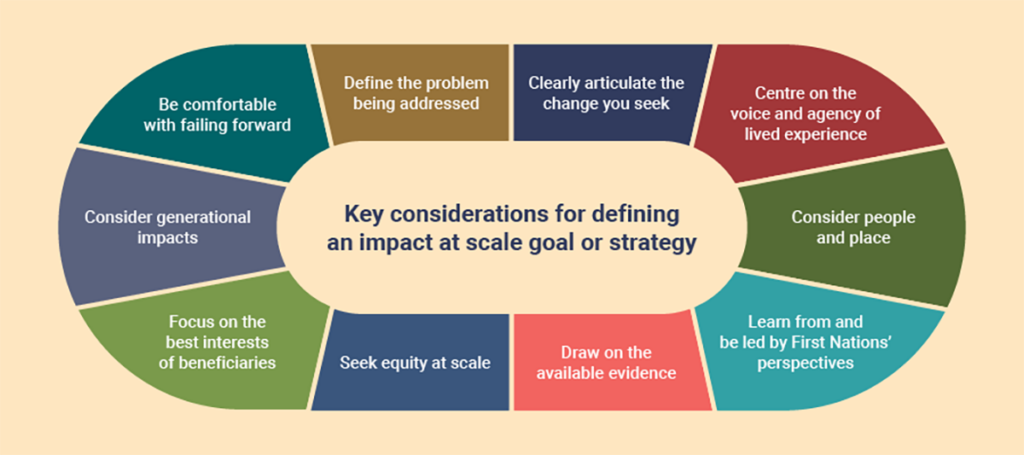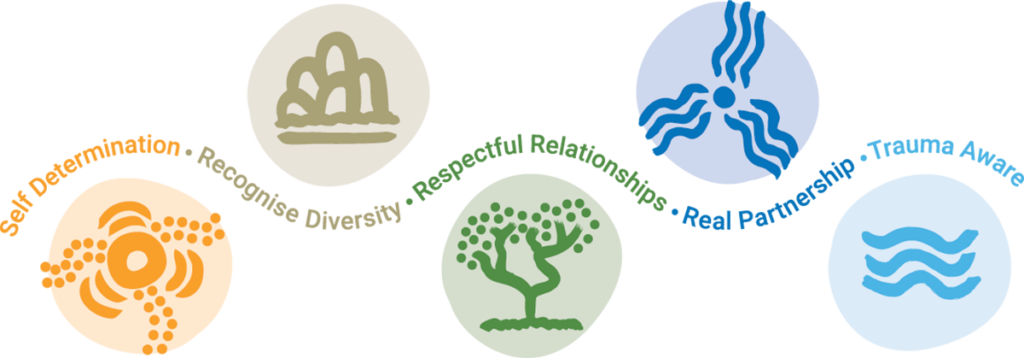
10 design principles for impact at scale
What are the key considerations in defining an impact at scale goal or strategy? SVA has identified 10 design principles.

- SVA convened many conversations with sector leaders condensing their experience and insights into 10 design principles for impact at scale.
- These design principles are not exhaustive but were seen to be important considerations for any impact at scale goal or strategy.
- Principles cover the need for work to be anchored in the voice and agency of lived experience, the importance of designing and planning for equity at scale, alongside learning from and sharing failures to accelerate collective efforts towards impact at scale.
SVA has been investigating one of the biggest challenges in the Australian social sector – what it takes to create impact at scale.
The result of this work, supported by the AMP Foundation and the Paul Ramsay Foundation, is our paper on Impact at Scale, which brings together a uniquely Australian set of perspectives on the topic.
To achieve this, SVA spoke with, surveyed and convened sector leaders from across the country and the public, private, philanthropic and non-government sectors. Through these conversations, we sought to understand the different experiences and pathways being adopted to work towards impact at scale, the enablers and barriers faced, and to share and test emerging insights.
The resulting paper explores four areas to support social purpose leaders and organisations to better understand and plan their efforts to drive lasting change across Australia:
- Defining impact at scale
- Pathways to work towards impact at scale
- Key considerations for defining an impact at scale goal or strategy
- Roles required to work towards an impact at scale goal or strategy.
In this series of SVA Quarterly articles on impact at scale we have already looked at some examples, and the issues and obstacles in scaling impact (see Five questions to consider when scaling for impact and What does it take to create large scale impact), and have explored the various frameworks for understanding impact at scale (see Frameworks for understanding impact at scale).
In this article, we will explore 10 design principles to be considered when defining an impact at scale goal or strategy. In a future article we will look at the roles required to work towards an impact at scale goal or strategy.
Overview
Our conversations with social purpose leaders highlighted a number of considerations that were seen to be important across impact at scale efforts.
Many highlighted the need for work to be anchored in the voice and agency of lived experience. The importance of designing and planning for equity at scale was also recognised as essential, alongside learning from and sharing failures to accelerate collective efforts towards impact at scale.
We have sought to capture these considerations as a set of design principles to inform the development of impact at scale strategies. These principles are broadly applicable to any aspiration for, and pathway towards, impact at scale.
Design principles for impact at scale
We have articulated ten design principles for impact at scale. While this is not an exhaustive list, our conversations with social purpose leaders have highlighted the following as critical features and techniques that can be used when planning and working towards impact at scale.
- Define the problem being addressed
- Clearly articulate the change you seek
- Centre on the voice and agency of lived experience
- Consider people and place
- Learn from and be led by First Nations’ perspectives
- Draw on the available evidence
- Seek equity at scale
- Focus on the best interests of beneficiaries
- Consider generational impacts
- Be comfortable with failing forward

Define the problem being addressed
Working towards impact at scale requires deep knowledge of the issue being addressed. And social purpose leaders working with the same general focus may have differing opinions on the particular problem they are addressing. Some may be focused on the ineffectiveness of services for beneficiaries, while others may be tackling negative community mindsets towards the issues impacting those beneficiaries.
Defining the problem can help social purpose leaders to define its underlying drivers and root causes, and therefore the opportunities to shift these factors. Often, social purpose leaders will see there are different drivers holding an issue in place and will recognise it is not always possible for one organisation to address all of them. This reinforces the powerful enabler of collaboration and partnerships in working to address social problems.
Clearly articulate the change you seek
Articulating what success looks like is a key step to understanding the pathways and roles that may be required. Social purpose leaders should consider the specific outcomes being sought from their efforts, who these outcomes are for, the scale of these outcomes (how deep or how broad), and what activities will lead to these outcomes. A scaling strategy or theory of change can be a helpful tool in articulating these aspirations.1
Defining the impact at scale goal also involves an appreciation of the potential timescale of change. For some goals, the outcomes being sought may be achieved in a shorter timeframe. However, working to shift entrenched disadvantage often involves ongoing and longer-term efforts.2
Centre the voice and agency of lived experience
Our engagement with social purpose leaders emphasised the importance of centring efforts on the voice of lived experience. This prioritises the needs, agency and self-determination of the beneficiaries supported.
When defining the aspiration of impact at scale, those with lived experience can support in articulating ‘what good looks like’. This is important as people and communities may differ in their views on priority outcomes and may identify outcomes which may not be apparent to others.
Further, those with lived experience will often have greater insight into what may or may not work to deliver better outcomes. They can help provide the deep, contextual understanding that is needed to design effective efforts towards impact at scale and create buy-in from the communities impacted.
Consider people and place
We consistently heard of the importance of context in working towards impact at scale. Fostering social change requires ongoing consideration of the diverse needs of different communities. An intervention that is successful for one group or region may not be for another.3 It is therefore important for social purpose leaders to consider factors including geography, demographics, mindsets and lived experiences of the communities that will be affected by the intervention.
For example, social purpose leaders may see that the experiences and challenges of regional and remote communities vary to those in metropolitan areas. Indeed, disadvantage is often locational, concentrated in particular regions and persisting over long periods of time.4 Similarly, supporting diverse cohorts of a community may require adaptation relevant to different cultural histories, languages, beliefs and world views.
Learn from and be led by First Nations perspectives
In line with the principle of centring the voice of lived experience, achieving impact at scale in Australia demands a prioritisation of the diversity, agency and self-determination of First Nations peoples. Such an approach is integral to ensuring that efforts are genuinely inclusive, effectively addressing the unique needs and goals of First Nations communities.
As SVA is not a First Nations organisation, we rely on the insights shared by First Nations leaders and organisations to guide our understanding of meaningful impact at scale. The following perspectives, while not exhaustive, offer valuable insights from these leaders and organisations. They provide guidance on how non-Indigenous social purpose leaders can engage with First Nations peoples, incorporating their views and leadership in efforts to achieve impact at scale.
In efforts to achieve impact at scale within First Nations communities, leadership and guidance from these communities are essential from the outset. This includes partnering with First Nations communities to establish their leading roles in defining problems, setting goals, and developing and evaluating solutions. Such an approach ensures that large-scale initiatives are deeply rooted in the unique voices, knowledge, and histories of First Nations peoples, essential for impactful and respectful outcomes.
Recognising that the challenges faced by First Nations peoples often stem from systemic and generational factors, efforts towards impact at scale must address broader institutional contexts, rather than solely focusing on changing community behaviours. This includes social purpose leaders and organisations acknowledging the systemic and generational trauma that many First Nations communities experience and an appreciation of how this trauma may influence efforts.
The nature and metrics of impact at scale as envisioned by First Nations communities can diverge from conventional frameworks. It’s therefore crucial to align impact at scale goals with the unique needs and interests of these communities. Indeed, impact at scale in the context of First Nations peoples is often rooted in community-based approaches, emphasising local perspectives, needs and cultural nuances.
Case study: First Nations Practice Principles at SVA
One way that SVA has demonstrated its commitment to learning from and being led by First Nations perspectives is through our First Nations Practice Principles (see below). Our First Nations Practice Principles provide us with guidance on how to respectfully engage with First Nations communities and organisations, ensuring a high standard of practice across the work we do.5

The five First Nations Practice Principles developed at SVA
Outside of direct efforts affecting First Nations communities, we believe social purpose leaders and organisations have an opportunity to learn from the perspectives of First Nations peoples across all impact at scale efforts. The wealth of knowledge our First Nations peoples hold can be applied to creating better social outcomes for all communities. This includes considering intergenerational effects and how efforts supporting communities today will have flow on effects for future generations.
Draw on the available evidence
Efforts towards impact at scale will be more effective when they draw on available evidence. This should include evidence on what works best, for whom, and in what circumstances.
Ensuring that people and communities are scaffolded with relevant frameworks, methods, data and evidence helps avoid wasted effort in ‘reinventing the wheel’. Evidence will typically consider real life examples and help define the pre-conditions for social change as well as the mechanisms of why and how an approach will help drive impact at scale. These insights are important for social purpose leaders and organisations as they should inform understandings about what makes an approach likely to work in different contexts and communities.
Seek equity at scale
Social purpose leaders frequently raised the need to work towards impact at scale that provides to all beneficiaries. This requires efforts to be tailored in how they support or reach different cohorts. This can pose a challenge given the diversity of people and place across Australia.
Designing for equity at scale becomes particularly important when considering large-scale service provision or interventions. It is often in larger interventions where the most disadvantaged can be forgotten or excluded from access.
The example of Goodstart Early Learning outlines how equity at scale can be embedded into an impact at scale ambition.
Case study: Goodstart Early Learning embedding inclusion as a strategic goal
Goodstart is the largest provider of early childhood education and care in Australia with over 660 centres operating across a diverse mix of regional and urban communities.
Equity of outcomes and inclusion is embedded within Goodstart’s impact at scale ambition of providing accessible, quality and inclusive early learning and care across Australia. Despite its broad reach, Goodstart has embedded inclusion as a foundational strategic goal which has been a critical step to supporting children experiencing vulnerability and disadvantage.
As a result, one third of children attending Goodstart centres have an identified vulnerability, and Goodstart outperforms the sector in servicing children who identify as First Nations, live with a disability or are from disadvantaged backgrounds. Goodstart then draws on this experience and its unique position in the sector to create evidence of what works at scale, and has successfully advocated for policy change to improve outcomes for all of Australia’s children.
Focus on the best interests of beneficiaries
For many social purpose organisations, scale or growth can be of interest for organisational reasons. It can provide genuine benefits like economies of scale, increased brand awareness, and the ability to attribute the scale of impact to potential funders. However, impact at scale requires a focus on ‘scaling of impact’ as opposed to ‘scaling the organisation’. These are not always equivalent.
Unlike organisations in the for-profit sector, social purpose leaders have a responsibility to prioritise social impact over organisational returns. This may result in an assessment that impact at scale can be better achieved through avenues other than growing the organisation, including partnerships, supporting the capabilities of other organisations, or open-source knowledge sharing.
Consider generational impacts
Many social purpose leaders, particularly First Nations leaders, highlighted the importance of prioritising intergenerational impact to create lasting outcomes for communities. Deep impact can create better social outcomes not only for beneficiaries directly served by efforts, but for future generations. This can sometimes positively affect a person’s children, their wider families, and the future community.
As such, there is a need for social purpose leaders to consider both the potential positive and negative consequences for future generations caused by their work. We note there are challenges associated with measuring intergenerational impact; it can require consistent, longitudinal data, which can be difficult to capture or beyond the funding scope of a program.
Be comfortable with failing forward
Social change is not linear, and often requires behaviour and mindset changes. Impact at scale will always be an ongoing process, requiring adaptation, flexibility and working in new and different ways to achieve the work’s aspiration. The journey is one of continuous, incremental learning and improvement. Social purpose leaders highlighted the importance of being willing to ‘fail’, reflect and learn, and change course along this journey.
Given this context, ‘failure’, or the inability to achieve the intended change, can be viewed as an opportunity to draw out key learnings and openly share these learnings with others to avoid the same pitfalls. Creating a culture of failing forward and continually learning can be a powerful enabler across sectors.
Conclusion
These 10 design principles are important considerations for working towards impact at scale in Australia. Though not exhaustive, they can broadly be applied to any impact at scale goal or strategy. Our hope is they provide useful provocations for social purpose leaders and organisations working towards impact at scale, supporting improved and more effective efforts.
Authors: Divya Roy and Nick Perini
- See J Gargani and R Mclean, ‘Scaling science’, Stanford Social Innovation Review, 2017.
- Research has identified that most social initiatives take over 25 years to reach their scaling goal. Susan W Ditkoff and A Grindle, ‘Audacious philanthropy: lessons from 15 world-changing initiatives’, Harvard Business Review, 2017.
- See J Gargani and R McLean, Scaling impact: innovation for the public good, Routledge, 2019.
- R Tanton, L Dare, R Miranti, Y Vidyattama, A Yule and M McCabe, Dropping off the edge 2021: Persistent and multilayered disadvantage in Australia, Jesuit Social Services, 2021.
- For further information on SVA’s First Nations Practice Principles see: Social Ventures Australia, First Nations Practice Principles, SVA, n.d.






